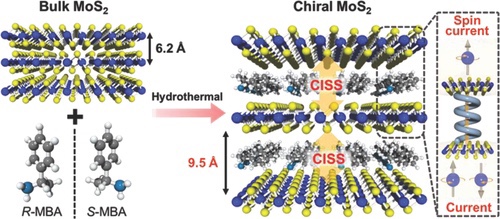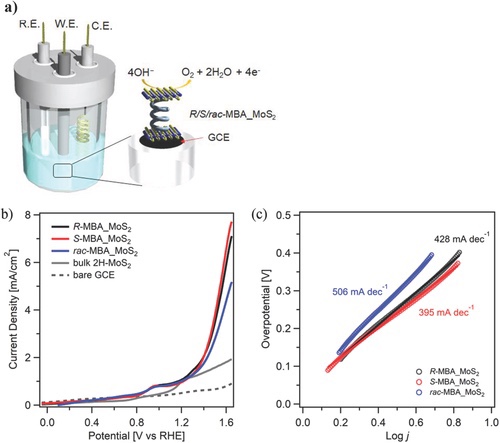

Kyoto University: Improve hydrogen generation efficiency by water electrolysis:
-Controlling the direction of electron spins in an electric current-
Kyoto University
Japan Science and Technology Agency (JST)
May 2,
Kyoto University has developed “Technology to improve the efficiency of hydrogen generation by water electrolysis”.
Properties of electron spin in current:
Chiral molecules were inserted between the layers of “molybdenum disulfide” (MoS2).
“Chiral MoS2” has “the property of aligning the directions of electron spins in an electric current in the same direction”
Found to have.
Oxygen evolution efficiency improved by 1.5 times:
This was used as an electrode material in water electrolysis (water electrolysis).
Due to the “current effect with aligned spin directions”
“Oxygen evolution efficiency, which was poor in water electrolysis efficiency”
Improved to “1.5 times that of Racemic MoS2 with no spin”.
Suppressing the production of hydrogen peroxide:
Furthermore, they found that “the production of hydrogen peroxide is suppressed by 70% or more”.
Main product spin state:
It is the main product of the oxygen evolution reaction.
Oxygen is a triplet with parallel spins,
Hydrogen peroxide is a singlet whose spins are antiparallel,
Has two spin states.
If it is possible to “align the directions of spins in an electric current in parallel and electrolyze water”,
It is conceivable that “oxygen in the triplet state can be selectively generated”.
Research team:
this time,
Pay attention to “a phenomenon in which the structure reflected in the mirror does not overlap with the original structure, such as the right and left hands.”
We used the “chirality-induced spin selectivity phenomenon” of chiral molecules.
Applied to the positive electrode of water electrolysis
This compound was applied onto a positive electrode (an electrode in which an oxygen evolution reaction occurs) in water electrolysis.
Oxygen evolution reaction efficiency:
It was also confirmed that the improvement was about 1.5 times compared to the case where the spin was not controlled (in the case of racemic MoS2 having a non-chiral structure).
TECH +
https://news.mynavi.jp/techplus/article/20220506-2339286/
Université de Kyoto : Améliorer l’efficacité de la génération d’hydrogène par électrolyse de l’eau :
-Contrôle de la direction des spins des électrons dans un courant électrique-
Université de Kyoto
Agence japonaise pour la science et la technologie (JST)Le 2 mai,
L’Université de Kyoto a développé une “Technologie pour améliorer l’efficacité de la génération d’hydrogène par électrolyse de l’eau”.
Propriétés du spin électronique dans le courant :
Des molécules chirales ont été insérées entre les couches de “disulfure de molybdène” (MoS2).
“Chiral MoS2” a “la propriété d’aligner les directions des spins électroniques dans un courant électrique dans la même direction”
Trouvé à avoir.
Efficacité de dégagement d’oxygène améliorée de 1,5 fois :
Cela a été utilisé comme matériau d’électrode dans l’électrolyse de l’eau (électrolyse de l’eau).
En raison de “l’effet de courant avec des directions de rotation alignées”
“Efficacité d’évolution de l’oxygène, qui était pauvre en efficacité d’électrolyse de l’eau”
Amélioré à “1,5 fois celui de Racemic MoS2 sans spin”.Suppression de la production de peroxyde d’hydrogène :
De plus, ils ont découvert que “la production de peroxyde d’hydrogène est supprimée de 70% ou plus”.
État d’essorage du produit principal :
C’est le produit principal de la réaction de dégagement d’oxygène.
L’oxygène est un triplet à spins parallèles,
Le peroxyde d’hydrogène est un singulet dont les spins sont antiparallèles,
A deux états de spin.S’il est possible “d’aligner les directions des spins dans un courant électrique en parallèle et d’électrolyser l’eau”,
Il est concevable que “l’oxygène à l’état triplet puisse être généré de manière sélective”.
Équipe de recherche:
cette fois,
Faites attention à “un phénomène dans lequel la structure réfléchie dans le miroir ne chevauche pas la structure d’origine, comme les mains droite et gauche”.
Nous avons utilisé le “phénomène de sélectivité en spin induite par la chiralité” des molécules chirales.
Appliqué à l’électrode positive de l’électrolyse de l’eau
Ce composé a été appliqué sur une électrode positive (une électrode dans laquelle se produit une réaction de dégagement d’oxygène) dans l’électrolyse de l’eau.
Efficacité de la réaction de dégagement d’oxygène :
Il a également été confirmé que l’amélioration était d’environ 1,5 fois par rapport au cas où le spin n’était pas contrôlé (dans le cas du MoS2 racémique ayant une structure non chirale).
TECH +
Universität Kyoto: Effizienz der Wasserstofferzeugung durch Wasserelektrolyse verbessern:
-Steuerung der Richtung von Elektronenspins in einem elektrischen Strom-
Universität Kyoto
Japanische Agentur für Wissenschaft und Technologie (JST)2. Mai,
Die Universität Kyoto hat eine „Technologie zur Verbesserung der Effizienz der Wasserstofferzeugung durch Wasserelektrolyse“ entwickelt.
Eigenschaften des Elektronenspins im Strom:
Zwischen die Schichten aus „Molybdändisulfid“ (MoS2) wurden chirale Moleküle eingefügt.
„Chirales MoS2“ hat „die Eigenschaft, die Richtungen von Elektronenspins in einem elektrischen Strom in die gleiche Richtung auszurichten“
Gefunden zu haben.
Effizienz der Sauerstoffentwicklung um das 1,5-fache verbessert:
Dieses wurde als Elektrodenmaterial bei der Wasserelektrolyse (Wasserelektrolyse) verwendet.
Aufgrund der “Stromwirkung bei ausgerichteten Drallrichtungen”
“Effizienz der Sauerstoffentwicklung, die bei der Wasserelektrolyse-Effizienz schlecht war”
Verbessert auf “das 1,5-fache von Racemic MoS2 ohne Spin”.Unterdrückung der Produktion von Wasserstoffperoxid:
Darüber hinaus fanden sie heraus, dass “die Produktion von Wasserstoffperoxid um 70 % oder mehr unterdrückt wird”.
Spinzustand des Hauptprodukts:
Es ist das Hauptprodukt der Sauerstoffentwicklungsreaktion.
Sauerstoff ist ein Triplett mit parallelen Spins,
Wasserstoffperoxid ist ein Singulett, dessen Spins antiparallel sind,
Hat zwei Spin-Zustände.Wenn es möglich ist, “die Richtungen der Spins in einem elektrischen Strom parallel auszurichten und Wasser zu elektrolysieren”,
Denkbar sei, dass „Sauerstoff im Triplett-Zustand selektiv erzeugt werden kann“.
Forschungsgruppe:
diesmal,
Achten Sie auf “ein Phänomen, bei dem die im Spiegel reflektierte Struktur nicht mit der ursprünglichen Struktur überlappt, wie z. B. die rechte und die linke Hand”.
Wir nutzten das “chiralitätsinduzierte Spinselektivitätsphänomen” chiraler Moleküle.
Angewandt auf die positive Elektrode der Wasserelektrolyse
Diese Verbindung wurde bei der Wasserelektrolyse auf eine positive Elektrode (eine Elektrode, in der eine Sauerstoffentwicklungsreaktion auftritt) aufgetragen.
Effizienz der Sauerstoffentwicklungsreaktion:
Es wurde auch bestätigt, dass die Verbesserung etwa das 1,5-fache im Vergleich zu dem Fall war, in dem der Spin nicht kontrolliert wurde (im Fall von racemischem MoS 2 mit einer nicht-chiralen Struktur).
TECH+
Hybrid Chiral MoS2 Layers for Spin‐Polarized Charge Transport and Spin‐Dependent Electrocatalytic Applications
Abstract
The chiral-induced spin selectivity effect
enables the application of chiral organic materials for spintronics and spin-dependent electrochemical applications.
It is demonstrated on various chiral monolayers, in which their conversion efficiency is limited.
On the other hand,
relatively high spin polarization (SP)is observed on bulk chiral materials; however, their poor electronic conductivities limit their application.
Here,
the design of chiral MoS2 with a high SP and high conductivity is reported.Chirality is introduced to the MoS2 layers through the intercalation of methylbenzylamine molecules.
This design approach
activates multiple tunneling channels in the chiral layers, which results in an SP as high as 75%.Furthermore,
the spin selectivity suppresses the production of H2O2 by-product and promotes the formation of ground state O2 molecules during the oxygen evolution reaction.These potentially improve the catalytic activity of chiral MoS2.
The synergistic effect is demonstrated
as an interplay of the high SP and the high catalytic activity of the MoS2 layer on the performance of the chiral MoS2 for spin-dependent electrocatalysis.
This novel approach
employed here paves way for the development of other novel chiral systems for spintronics and spin-dependent electrochemical applications.– Advanced Science – Wiley Online Library